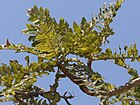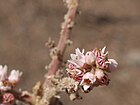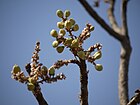Note: This is a project under development. The articles on this wiki are just being initiated and broadly incomplete. You can Help creating new pages.
Difference between revisions of "Boswellia serrata - Shallaki"
| (6 intermediate revisions by the same user not shown) | |||
| Line 1: | Line 1: | ||
[[File:Boswellia serrata (Salai) in Kinnarsani WS, AP W2 IMG 5840.jpg|thumb|right|''Shallaki'', ''Boswellia serrata'']] | [[File:Boswellia serrata (Salai) in Kinnarsani WS, AP W2 IMG 5840.jpg|thumb|right|''Shallaki'', ''Boswellia serrata'']] | ||
| − | |||
'''Boswellia serrata''' is a plant that produces Indian frankincense, Salai, referred to in Sanskrit as shallaki and in Latin as Olibanum Indicum. the plant is native to much of India and the Punjab region that extends into Pakistan. | '''Boswellia serrata''' is a plant that produces Indian frankincense, Salai, referred to in Sanskrit as shallaki and in Latin as Olibanum Indicum. the plant is native to much of India and the Punjab region that extends into Pakistan. | ||
==Uses== | ==Uses== | ||
{{Uses|Arthritis}}, {{Uses|Joint pain}}, {{Uses|Chronic inflammatory diseases}}, {{Uses|Bronchial asthma}}, {{Uses|Ulcerative colitis}}, {{Uses|Crohn's disease}}, {{Uses|Chronic lung diseases}}, {{Uses|Diarrhoea}}, {{Uses|Dysentery}}, {{Uses|Pulmonary diseases}}. | {{Uses|Arthritis}}, {{Uses|Joint pain}}, {{Uses|Chronic inflammatory diseases}}, {{Uses|Bronchial asthma}}, {{Uses|Ulcerative colitis}}, {{Uses|Crohn's disease}}, {{Uses|Chronic lung diseases}}, {{Uses|Diarrhoea}}, {{Uses|Dysentery}}, {{Uses|Pulmonary diseases}}. | ||
<ref name="Uses"/> | <ref name="Uses"/> | ||
| + | |||
| + | ===Food=== | ||
| + | Shallaki can be used in food. It's Fruits are pickled<ref name="Forest foods of Western Ghat"/>. | ||
==Parts Used== | ==Parts Used== | ||
| Line 13: | Line 15: | ||
==Common names== | ==Common names== | ||
| − | {{Common names|sa= | + | {{Common names|sa=Bahusrava, Gajabhaksha, Sallaki, Yakshadhupa, Salasiniryasam|en=Boswellia serrata|hi=Salai|kn=Madi, Guggala, Guggaladupa, Guggula mara|ml= Koonthrakum, Kuntirikkam, Manna-Kungiliyam, Sambrani, Valanku-chambrani|mr=Saalayi, Salaphal|ta=Kundurukkan, Kungiliyam, Kungli, Vellai kunkiliyam|te=Dhupamu, Guggilamu, Parangisambrani, Tellaguggilamu, Andugapisunu}} |
<ref name="Common names"/> | <ref name="Common names"/> | ||
| Line 30: | Line 32: | ||
===Prabhava=== | ===Prabhava=== | ||
| + | |||
| + | ===Nutritional components=== | ||
| + | Shallaki contains the Following nutritional components like Vitamin-C; Calcium, Iron, Manganese, Magnesium, Phosphorus, Potassium, Sodium<ref name="Forest foods of Western Ghat"/> | ||
==Habit== | ==Habit== | ||
| Line 36: | Line 41: | ||
==Identification== | ==Identification== | ||
===Leaf=== | ===Leaf=== | ||
| − | {{Leaf|Pinnate|Alternate|Apically clustered, estipulate; rachis 11-44 cm, slender, pubescent, swollen at base; leaflets 15-31, sessile or subsessile, opposite or subopposite | + | {{Leaf|Pinnate|Alternate|Apically clustered, estipulate; rachis 11-44 cm, slender, pubescent, swollen at base; leaflets 15-31, sessile or subsessile, opposite or subopposite. }}<ref name="Leaf"/> |
===Flower=== | ===Flower=== | ||
| − | {{Flower|Bisexual|Axillary sub-terminal racemes| | + | {{Flower|Bisexual|Axillary sub-terminal racemes|White|10|Calyx pubescent, tube broadly campanulate, short; lobes 5-7, persistent.}} |
===Fruit=== | ===Fruit=== | ||
| − | {{Fruit|Drupe|12 mm long||| | + | {{Fruit|Drupe|12 mm long|||Ovoid, trigonous; pyrenes 3; seed 3.|}} |
===Other features=== | ===Other features=== | ||
| Line 53: | Line 58: | ||
{{Propagation|Seeds}} | {{Propagation|Seeds}} | ||
| − | == | + | ==Cultivation Details== |
| − | Seeds are sown immediately after collection. The rate of germination is about 25-30 % | + | Seeds are sown immediately after collection. The rate of germination is about 25-30 %<ref name="How to plant/cultivate"/>. Shallaki is available through February to June<ref name="Forest foods of Western Ghat"/>. |
| − | <ref name="How to plant/cultivate"/> | + | |
| + | ==Season to grow== | ||
| + | Summer. | ||
| + | |||
| + | ==Required Ecosystem/Climate== | ||
| + | It prefers dry, hot exposures of rocky hills, with 50-125 cm rainfall.<ref name="Required Ecosystem/Climate"/> | ||
| + | |||
| + | ==Kind of soil needed== | ||
| + | It can be grown in red, lateritic to rocky soils of dry deciduous forests and on dry sand stone ridges. | ||
==Commonly seen growing in areas== | ==Commonly seen growing in areas== | ||
| Line 75: | Line 88: | ||
<ref name="Uses">[https://easyayurveda.com/2015/07/14/shallaki-boswellia-serrata/ Uses]</ref> | <ref name="Uses">[https://easyayurveda.com/2015/07/14/shallaki-boswellia-serrata/ Uses]</ref> | ||
<ref name="How to plant/cultivate">[http://vikaspedia.in/agriculture/crop-production/package-of-practices/medicinal-and-aromatic-plants/asparagus-adscendens-1 Cultivation details]</ref> | <ref name="How to plant/cultivate">[http://vikaspedia.in/agriculture/crop-production/package-of-practices/medicinal-and-aromatic-plants/asparagus-adscendens-1 Cultivation details]</ref> | ||
| + | <ref name="Required Ecosystem/Climate">[https://vikaspedia.in/agriculture/crop-production/package-of-practices/medicinal-and-aromatic-plants/boswellia-serrata Required Ecosystem/Climate]</ref> | ||
| + | <ref name="Forest foods of Western Ghat">"Forest food for Northern region of Western Ghats" by Dr. Mandar N. Datar and Dr. Anuradha S. Upadhye, Page No.31, Published by Maharashtra Association for the Cultivation of Science (MACS) Agharkar Research Institute, Gopal Ganesh Agarkar Road, Pune</ref> | ||
</references> | </references> | ||
Latest revision as of 18:15, 21 October 2021
Boswellia serrata is a plant that produces Indian frankincense, Salai, referred to in Sanskrit as shallaki and in Latin as Olibanum Indicum. the plant is native to much of India and the Punjab region that extends into Pakistan.
Contents
- 1 Uses
- 2 Parts Used
- 3 Chemical Composition
- 4 Common names
- 5 Properties
- 6 Habit
- 7 Identification
- 8 List of Ayurvedic medicine in which the herb is used
- 9 Where to get the saplings
- 10 Mode of Propagation
- 11 Cultivation Details
- 12 Season to grow
- 13 Required Ecosystem/Climate
- 14 Kind of soil needed
- 15 Commonly seen growing in areas
- 16 Photo Gallery
- 17 References
- 18 External Links
Uses
Arthritis, Joint pain, Chronic inflammatory diseases, Bronchial asthma, Ulcerative colitis, Crohn's disease, Chronic lung diseases, Diarrhoea, Dysentery, Pulmonary diseases. [1]
Food
Shallaki can be used in food. It's Fruits are pickled[2].
Parts Used
Chemical Composition
Many derivatives of 3-keto-methylbeta-boswellic ester, isolated from the gum-resin., have been prepared. Gum-resin contains triterpenes of oleanane, ursane and euphane series. [3]
Common names
| Language | Common name |
|---|---|
| Kannada | Madi, Guggala, Guggaladupa, Guggula mara |
| Hindi | Salai |
| Malayalam | Koonthrakum, Kuntirikkam, Manna-Kungiliyam, Sambrani, Valanku-chambrani |
| Tamil | Kundurukkan, Kungiliyam, Kungli, Vellai kunkiliyam |
| Telugu | Dhupamu, Guggilamu, Parangisambrani, Tellaguggilamu, Andugapisunu |
| Marathi | Saalayi, Salaphal |
| Gujarathi | NA |
| Punjabi | NA |
| Kashmiri | NA |
| Sanskrit | Bahusrava, Gajabhaksha, Sallaki, Yakshadhupa, Salasiniryasam |
| English | Boswellia serrata |
Properties
Reference: Dravya - Substance, Rasa - Taste, Guna - Qualities, Veerya - Potency, Vipaka - Post-digesion effect, Karma - Pharmacological activity, Prabhava - Therepeutics.
Dravya
Rasa
Guna
Veerya
Vipaka
Karma
Prabhava
Nutritional components
Shallaki contains the Following nutritional components like Vitamin-C; Calcium, Iron, Manganese, Magnesium, Phosphorus, Potassium, Sodium[2]
Habit
Identification
Leaf
| Kind | Shape | Feature |
|---|---|---|
| Pinnate | Alternate | Apically clustered, estipulate; rachis 11-44 cm, slender, pubescent, swollen at base; leaflets 15-31, sessile or subsessile, opposite or subopposite. |
Flower
| Type | Size | Color and composition | Stamen | More information |
|---|---|---|---|---|
| Bisexual | Axillary sub-terminal racemes | White | 10 | Calyx pubescent, tube broadly campanulate, short; lobes 5-7, persistent. |
Fruit
| Type | Size | Mass | Appearance | Seeds | More information |
|---|---|---|---|---|---|
| Drupe | 12 mm long | Ovoid, trigonous; pyrenes 3; seed 3. |
Other features
List of Ayurvedic medicine in which the herb is used
Where to get the saplings
Mode of Propagation
Cultivation Details
Seeds are sown immediately after collection. The rate of germination is about 25-30 %[6]. Shallaki is available through February to June[2].
Season to grow
Summer.
Required Ecosystem/Climate
It prefers dry, hot exposures of rocky hills, with 50-125 cm rainfall.[7]
Kind of soil needed
It can be grown in red, lateritic to rocky soils of dry deciduous forests and on dry sand stone ridges.
Commonly seen growing in areas
Dry hill areas, Dry deciduous forest.
Photo Gallery
References
- ↑ Uses
- ↑ 2.0 2.1 2.2 "Forest food for Northern region of Western Ghats" by Dr. Mandar N. Datar and Dr. Anuradha S. Upadhye, Page No.31, Published by Maharashtra Association for the Cultivation of Science (MACS) Agharkar Research Institute, Gopal Ganesh Agarkar Road, Pune
- ↑ Chemical composition
- ↑ Vernacular names
- ↑ BOTANIC DESCRIPTION
- ↑ Cultivation details
- ↑ Required Ecosystem/Climate
External Links
- Ayurvedic Herbs known to be helpful to treat Arthritis
- Ayurvedic Herbs known to be helpful to treat Joint pain
- Ayurvedic Herbs known to be helpful to treat Chronic inflammatory diseases
- Ayurvedic Herbs known to be helpful to treat Bronchial asthma
- Ayurvedic Herbs known to be helpful to treat Ulcerative colitis
- Ayurvedic Herbs known to be helpful to treat Crohn's disease
- Ayurvedic Herbs known to be helpful to treat Chronic lung diseases
- Ayurvedic Herbs known to be helpful to treat Diarrhoea
- Ayurvedic Herbs known to be helpful to treat Dysentery
- Ayurvedic Herbs known to be helpful to treat Pulmonary diseases
- Herbs with Flowers used in medicine
- Herbs with Seeds used in medicine
- Herbs with common name in Kannada
- Herbs with common name in Hindi
- Herbs with common name in Malayalam
- Herbs with common name in Tamil
- Herbs with common name in Telugu
- Herbs with common name in Marathi
- Herbs with common name in Sanskrit
- Herbs with common name in English
- Habit - Deciduous tree
- Index of Plants which can be propagated by Seeds
- Herbs that are commonly seen in the region of Dry hill areas
- Herbs that are commonly seen in the region of Dry deciduous forest
- Herbs
- Ayurvedic herbs that don't have seed photos
- Burseraceae




